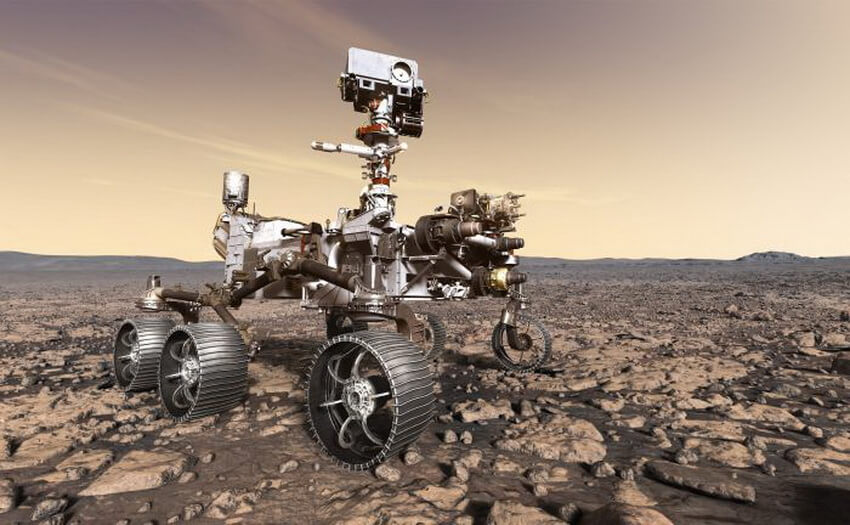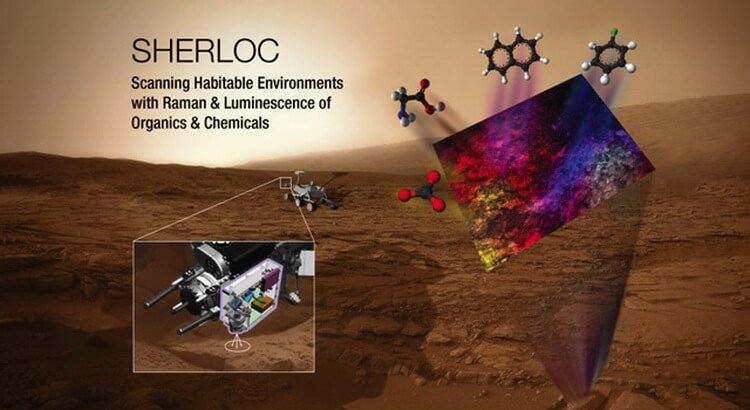
In July 2020, the space Agency NASA will send to Mars mobile Autonomous new science lab. Following “opportunity” and “Curiosity” the new Rover will attempt to find answers to intriguing questions. Scientists want to learn whether the Red planet suitable for living conditions in the past and lived on it for at least the germs.
To solve these mysteries, the Mars Rover 2020 will need to obtain samples of Martian rock drilling, to carry out tests and to put them what is called “in reserve”. Astronauts of future manned missions to Mars will be able to bring them back to Earth for further analysis. In the latest news space Agency NASA announced that the Mars Rover 2020 will be part of a Martian meteorite that fell once to the Ground. It is planned to send back to Mars and be used to calibrate new high-precision laser scanner SHERLOC (Scanning Habitable Environments with Raman and Luminescence for Organics and Chemicals).
The Agency reports that the laser can irradiate even the tiniest particles of Mars, which can potentially contain fossils of microorganisms. But in order to install a working rule, it requires the calibration target.

Mounted on a robotic arm of the Rover system SHERLOC will consist of spectrometers, lasers, and cameras, by which it will search for organics and minerals, which in the past could be exposed to water, and contact with microbial life
As a rule, for the calibration of such laser systems are used particles of stones, metal or glass, that is, samples resulting from a complex geological history. However, in the case of SHERLOC system engineers at the jet propulsion Laboratory decided to approach the problem with an innovative idea. For billions of years, Mars was bombarded by meteors, asteroids and comets, which raised the upper layers of the planet up. Some of this breed just flew into space, while others could go to other planets and including came to Earth in the form of meteorites. Some of these meteorites, scientists have discovered and explored.
Experts note that these samples are unique and will not resemble that breed, which will have to face Mars Rover in 2020. Nevertheless, they represent an ideal target for calibration.
“We study samples at such a subtle level that even small changes in temperature or even just the movement of the Rover in the sand may require new calibration. By examining how the tool will see your goal, we can understand how he would see his target on the Martian surface,” explains Luther Beagle from the jet propulsion Laboratory (JPL), which is the main specialist of the SHERLOC system.
The same instrument of the Curiosity Rover ChemCam (Chemistry and Camera) uses the technique of laser optical emission spectrometry to determine the composition of rocks and soil that it collects. Mars Rover “opportunity”, in turn, uses a compact spectrometer thermal emission (Mini-TES), which allows it to identify interesting samples and their composition from a distance.

Rohit Bhartia, one of the team members of the mission “Mars 2020” holding a piece of Martian meteorite, which will go home
The SHERLOC system in this regard is unique and will be the first science instrument on Mars, which will use the technology of Raman and fluorescence spectroscopy. The first feature consists in the irradiation of the test material visible, near infrared or middle ultraviolet radiation and the study of how to react to photons. Depending on how to change energy levels (decrease or, conversely, to rise), it is possible to determine the presence in the sample of certain chemical elements.
Fluorescence spectroscopy relies on the use of ultraviolet lasers that excite in carbon compounds the electrons and thereby cause them to glow, indicating the presence of life (i.e. biosignatures). In addition, SHERLOC will be to shoot samples of stones and rocks that he will study that will allow the scientific team to map the chemical signatures that will be detected on the surface of Mars.
For these purposes, the scientific team SHERLOC will need a control sample. And quite robust sample, capable of withstanding intense vibration during the launch of the Rover from Earth and landing it on the Red planet. In addition, it is necessary that the sample contained the proper chemical elements to calibrate the sensitivity SHERLOC for the presence of biosignature. To the delight of engineers and scientists from JPL, came to the aid of Johnson Space center in Houston and also London science Museum that provided the sample of the meteorite Sayḩ al Uhaymir 008 (abbreviated SaU008).
This meteorite was found in Oman in 1999 and proved to be stronger than other meteorites. It can be cut into several pieces. Thus, SaU008 will be the first Martian meteorite, which will help scientists find signs of life on this planet. Although technically it will not be the first meteorite, which is at least partially, but will return back to their home planet.

A piece of the meteorite from Mars, placed inside the camera cleaning the outer layers of any organic substances
That honor belongs to Zagami meteorite, discovered in Nigeria in 1962. Part of it was sent back to Mars on Board the spacecraft Mars Global Surveyor (MGS) in 1999. This mission ended in 2007, so a piece of the meteorite is still floating in orbit of the red planet.
In addition to the SHERLOC system team of the project “Mars 2020” is going to use scientific instrument SuperCam, which will also be a study of Martian rock. Along with part of a meteorite SaU008 to Mars will also be sent samples of some advanced materials. Besides the fact that they will also be used for the calibration of SHERLOC, these materials will be tested for resistance to the Martian weather and radiation. If they are sturdy enough to survive the Martian conditions, in the future they can be used for production of space suits, gloves and helmets.
“Scientific instrument SHERLOC is both a valuable opportunity to better prepare for manned flights and to conduct fundamental scientific investigations of the Martian surface. It will allow us to test the materials that will be able to protect future astronauts who go to Mars,” says mark freis, another engineer of the SHERLOC system, as well as curator of the division for the study of extraterrestrial materials at the Johnson Space center.
With each new robotic mission to Mars, NASA and other space agencies closer to the day when people will be able to land on the Red planet.
Along with the new Mars Rover in 2020 to Mars will fly her “loose part»
Nikolai Khizhnyak